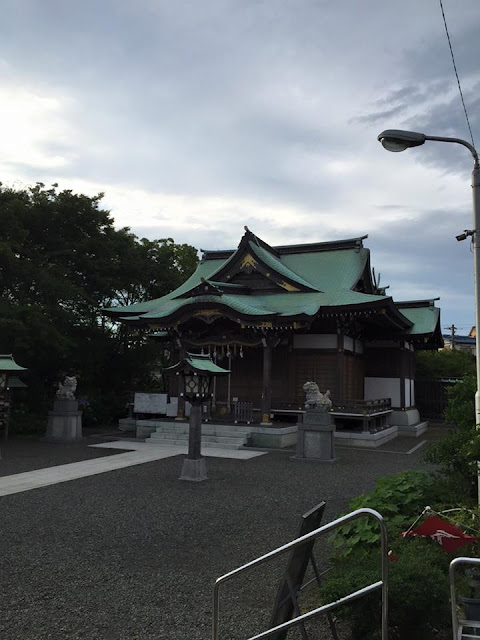Footing It Along the Tokaido, Sort Of (Kamakura II)
6/27
Sorry ladies and gents, it's been awhile. To make it up to you, I've got two back-to-back posts for you all, if I can write them. Last weekend I was invited by one of the professors at Toshidai to stay a night at his house in Kamakura. I did, and afterwards went to Enoshima, a small island to the southwest, for a day.
The title is a reference to genroku-era farce about two idiots who travel the length of the Tokaido. I only read a short episode from the novel (in class last semester), but would like to get around to reading the entire story. I did a fair bit of walking last weekend, it's true, but took the train for the part along the historical Tokaido...
Again, this post is probably best done in pictures.
I showed up late to my meeting with Kurata-sensei at Kamakura station, which seemed disastrous. I realized at Kikuna (about a third of the way to Kamakura) that I had forgotten my meticulously-wrapped presents for his two kids in my room, and decided to turn back to get them. I'm still not sure which would be ruder, being late to a first meeting or not bringing my gift, but I suspect that I screwed up again by deciding to go back... Kurata-san and his family were very kind when I arrived, and we took the bus to explore a bit of Kamakura before lunch.
Hokokuji
 |
| First stop was Hokokuji, the historical family temple of the Uesugi and Ashikaga clans. Quick history aside: the Ashikaga were shoguns from 1338 to 1573, although they had lost power long before Oda Nobunaga officially ended the shogunate (I think I've mentioned them before). The Uesugi were a powerful clan to emerge in the late Sengoku (Warring States) Period, and were one of a council of five families that briefly ruled Japan after Hideyoshi's death. The temple is at the base of a set of steep cliffs, and the remains of several members of the two clans are said to be interred in the caves at the base. The temple is also famous for its bamboo gardens, which look exactly as you would imagine a bamboo garden to look. |
 |
| The grave of an ancient head monk of the temple. Zen Buddhist monks are interred beneath five-tiered gravestones, each corresponding to an element of Buddhist cannon. The tiers, in order from bottom to top, represent earth, water, fire, wind and heaven. The tiers each have a prescribed shape, although this one, placed prominently in the temple grounds and made of unhewn stones, could predate that convention. Expertise on Zen Buddhist burial practices courtesy of Kurata-sensei. |
Sugimotodera
 |
| Sugimotodera is the oldest temple in Kamakura, having been built during the Nara period, around ~800AD. This is perhaps best illustrated by this famous staircase to the main temple, which is so worn by climbers' feet and compression of the ground underneath that the stairs all slope noticeably downhill. Climbing is prohibited, probably for both preservation and safety considerations. A side staircase to the top offers a nice view of downtown Kamakura. |
 |
| Guarding the entrance to Sugimotodera (and most other Buddhist sites) are the statues of two deities called (as best as I could tell) 'Un' and 'Ah'. Pretty sure these are contractions of their full names, Ungyo and Agyo. From my sample size of two, you can tell the two apart because Ah will have his mouth open and Un's will be closed, as though they were pronouncing their names. |
We headed home for lunch, which I think deserves a separate post. I'll conclude with the last temple (shrine, actually) we went to on Saturday,
Ryukomyo Jinja
 |
| This shrine is dedicated to an ancient dragon deity of local Shinto mythology. More on the legend later (see 'Enoshima'), but the dragon is said to have been pacified by Benzaiten, the goddess of music, and now resides a few blocks from Kurata-sensei's house. I learned more about the differences between shrines and temples today, as Buddhist temples often ask an entrance fee while Shinto shrines are generally free to enter. Also, one bows twice, claps twice, and then prays only at shrines; at temples you simply bow and pray. Tourists can spot the difference from the name--'jinja' for shrines versus 'tera' or 'ji' for temples--or from the decoration. Jinja have rattles with bell-pulls for calling out the shrine's deity, and visitors are free to make a racket while worshipping. |
 |
| Paid 200 yen for a fortune with Kurata-sensei's two kids. Ira-chan (the younger sister) lucked out with 'dai-kichi,' which is the best luck. I got 'kichi,' was told to sell my stocks, and received a tiny golden daruma (dharma) to match the larger red one I picked up at Sugimotodera. I think it's cool that the Kurata family is Christian, but have no problem participating in Buddhist and Shinto traditions. The religious history of Japan is particularly fascinating, and the intersection of many different religions over time has generated uniquely Japanese versions of some religions, notably Buddhism and Confucianism, that openly incorporate influences from others. I've heard it is common for modern Japanese to observe Christian, Shinto and Buddhist rites for different parts of their lives. |
Edit: the goddess of Enoshima is Benzaiten, not Kannon...






No comments:
Post a Comment